
 |
Experiences in Cross Curricula and Cross Border Teaching
|
| Versión española, , Deutsche Version |
By the Edmund Ohlendorf, IWB Radolfzell e.V., GERMANY, 2000
Contribution to EDUVINET Didactically and Methodically:
Internet and Teaching
I Introductory Remarks
Even before World War II
individual attempts were made in some European countries to move away from the
traditional teacher-centred lesson in favour of greater active student participation,
but until the 1970's such alternatives, in grammar schools at least, received
little attention.
Then until the 1980's two opposing trends were to be seen, i.e. on the one hand
in growing differentiation of lesson contents through partly new school subjects
or even the creation of different school types with technical, linguistic or
economic bias; on the other hand education reforms in the 1970's strengthened
efforts to give greater consideration to students' learning needs through pair
and group work and projects.
From the mid-80's block teaching and learning were given a new incentive by
the so-called key qualifications in response to the requirements of industry
and of particular importance in vocational training institutions.
Table 1A provides a conspectus of education contents and aims up to the 1980's.
Fig.1.1B shows the traditional classroom organisation, for decades accepted
as the normal set-up, with more or less all impulses starting from the teacher,
the students being receptively involved. This kind of teaching - if it is to
work - demands a large measure of discipline, willingness to learn and concentration
on the part of the students.All three qualities were becoming rarer among young
people at the end of the twentieth century and had to be imposed by the teacher,
sometimes with repressive measures, which can lead to an authoritarian type
of teaching.
Group Teaching (Vd. Fig.1.2.B) leaves students greater freedom for their own
creative solutions and most key qualifications can only be attained in this
way. Group teaching, moreover, is much better preparation for life in society
and at work than the traditional set-up. Even in foreign language teaching hundreds
of teachers have tried for years to find new ways. In Germany a whole new network
has been developed to allow teachers to exchange examples and experiences of
the "Learning through teaching" method. http://www.ldl.de
In many cases group teaching can be carried out by one teacher alone, as even
in group-work with different tasks different aspects within one subject or topic
are dealt with. If the teacher is qualified in two or even three subjects, then
of course he can cross subject boundaries. In vocational institutions there
are many cases where practical solutions can only be found by involving different
subjects, such as metalwork or electrotechnology, in mechanical engineering
and energy technology.
* Translation of the German original: "Erfahrungen mit fächer- und grenzüberschreitendem Unterricht im Jahre 2000"
by Gillian Johnson
| Tab. 1 A B Educational Contents and Aims up to the 1980's | |
| Specialisation
and teaching knowledge in different subjects |
Thinking and
connecting Block teaching |
Mathematics Chemistry Physics Mother tongue Classics Modern languages History Politics Geography Economics Data processing Religious instruction Ethics (Philosophy) Art Physical education Each subject is first and foremost guided by the claims of the relevant science, its aims, contents and to an extent by its methods. |
Student participation
So-called key qualifications include
|
| Abb.
1.1 B Frontalunterricht Fig. 1.1 B Traditional way of teaching and learning |
|
 |
| Abb.
1.2 B Gruppenunterricht (arbeitsgleich oder arbeitsteilig) Fig. 1.2 B Groups of students working in teams (on the same task or on different ones) |
|
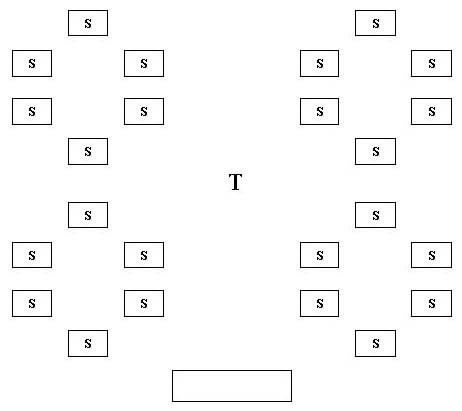 |
It is probably true to
say that cross curricula teaching in grammar schools in Europe has been the
exception rather than the rule.
There is a number of reasons for this:
This situation will, however, soon change,
Figure 2 B shows how cross
curricula teaching involves two, three or even four teachers at a time. This
does not mean an immediate increase in teaching hours per class, but each teacher
uses part of the time designated in the timetable for a particular class for
a coordinated (subject overlapping) solution of tasks or projects. This of course
demands from teachers team-work they were not trained for. On the other hand
society insists more and more that they teach students key qualifications such
as team-work, social and media skills.
| Tab.
2 A Why is it necessary and why does it make good sense to teach and to use information and communication technology (ICT)?*) |
|
| Social necessity | Reasons in practise and learning psychology |
To the above-mentioned key qualifications in Table 1 A media skills, especially Internet, have been important since the 1990's. Three aspects in particular of the Internet are growing in importance in our society and therefore cannot be ignored in teaching.
|
|
| *Further
information on the topic "Different Aspects of Using the Internet
in School and ODL " can be found at http://www.eduvinet.de/eduvinet/de015.htm |
|
| Abb.
2 B Fächerübergreifender Unterricht Fig. 2 B Cross curricula teaching and learning Unterrichtsorganisation/organisation of lessons |
|
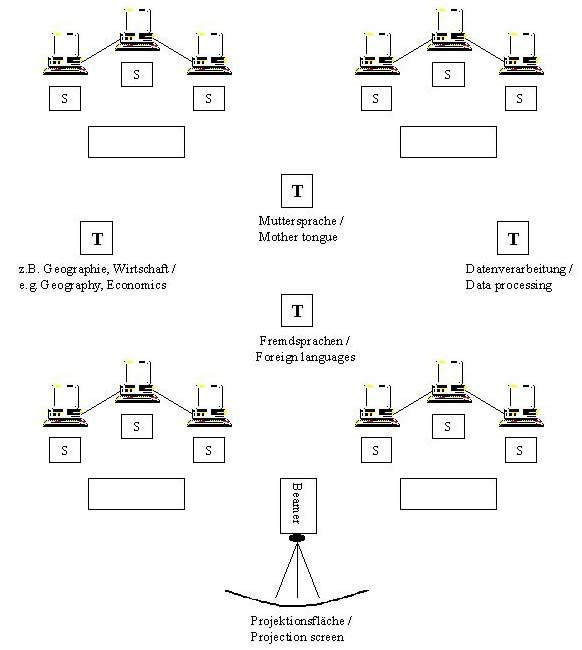
|
III What has the EDUVINET project done to improve the situation described above?
When in 1995 a relatively
small group of only three people - an economics teacher, a teacher of history,
politics and geography and a data-processing expert - set about formulating
a request for a SOKRATES ODL pilot project, it really was breaking new ground,
for at that time in Germany there was little experience with using Internet
in schools and none with with cross curricula teaching combined with ICT.
Firstly we had to make our own ideas fit the aims of the SOKRATES ODL programme.
Table 3 A shows how we were broadly successful in this, although in 1995/96
Brussels was probably thinking rather of the University over the Air than of
distance learning in the work of normal secondary schools.
Organising the realisation of this project sometimes proved very difficult between
1996 and 1998 (Vd. Fig. 3 B). At first we adopted the so-called "top down"
method, i.e. project partners drew up in discussion three topic areas for the
development of teaching materials on a European level:
These materials were to
serve as the basis for teacher discussions and student work in member countries
of the EU.
The three topic areas were determined by the interests of the EU and of the
teachers, who were thinking far beyond the possibilities of their own national
curricular. On the one hand this meant a certain dependence on university teachers
and practical eonomists, on the other hand the content and sometimes style of
language proved to be within the grasp only of very good students. Moreover,
the above topics were only a very small part of the school curricula at the
time.
This was also partly due to the fact that it is much more difficult in general
subjects than in science to agree on topics of equal importance to many member
countries.When after long discussions they were found, there was still the problem
of translating into the languages of the other member countries. Either there
was not enough money or there were not enough bilingual colleagues among the
project partners who were able to translate materials.
The EDUVINET team published well over 1000 Internet pages in two years, but
it is difficult to know how many were actually used in teaching in different
member countries. Even if the EDUVINET Service is visited 300 to 400 times a
day it is often the language of the material offered or that of the visitor
that determines the use of the pages.
| Tab.
3 A European Educational Aims in the SOKRATES Programme (Selection) |
|
| General Aims (1995-1999)
|
EDUVINET Project Aims (1996-1998)
|
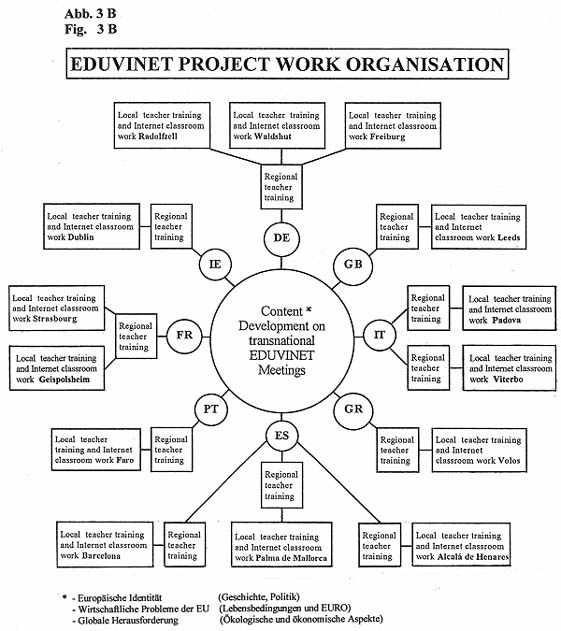
| Tab. 4 A EDUVINET Service Developments since 1998 | |
| Increased offer of teaching materials
Publication of teaching method experiences
|
Promoting students' comunicative competence, across national boundaries, too
Publication of student work
|
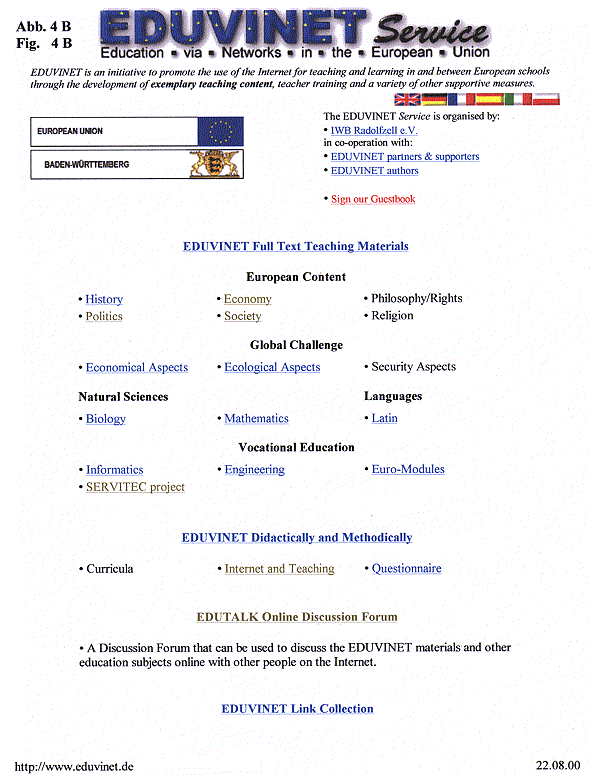
IV Information and Communication Technology in National Curricula
In August 1998 the end
of the EDUVINET project saw two different developments which have to some extent
left their mark in the EDUVINET Service (http://www.eduvinet.de) (Vd.
Table 4 A).
Thanks to the personal involvement of colleagues from the sciences ICT utilisation
saw a rapid increase, which can also be noted in statistics on users of the
EDUVINET Service .
There are two reasons for this:
Since with one exception
the materials are in German, they are inaccessible to non-German speakers.
Here the EU Commission could provide electronic manuals at relatively little
cost and thus contribute towards comparability of student achievement in different
member countries of the EU.
V Information and Communication Technology at the service of Transnationality
Table 5 A shows how teaching across national borders is not only desirable but
thanks to ICT provides a feasible new dimension in teaching.
The cross curricula group and project teaching described in Chapter II and Fig.
2 B is extended through international or transnational components. It is important
for teachers to have previously agreed on common topics. Such topics can be
found in several languages at:
http://www.eduvinet.de/eduvinet/inunt.htm
For best results many more details must be clarified; the more accurately this
is done, the better student work can be compared.
| Tab.
5 A Transnationality- Why is cross border teaching sensible and necessary? |
|
| Political reasons:
Economic reasons:
Psychological reasons:
|
| Abb.
5 B Fächer- und grenzüberschreitender Unterricht mit Hilfe der Informations-
und Kommunikationstechnologie (IKT) Fig. 5 B Cross curricula and cross border education by using Information and Communication technology (ICT) |
|
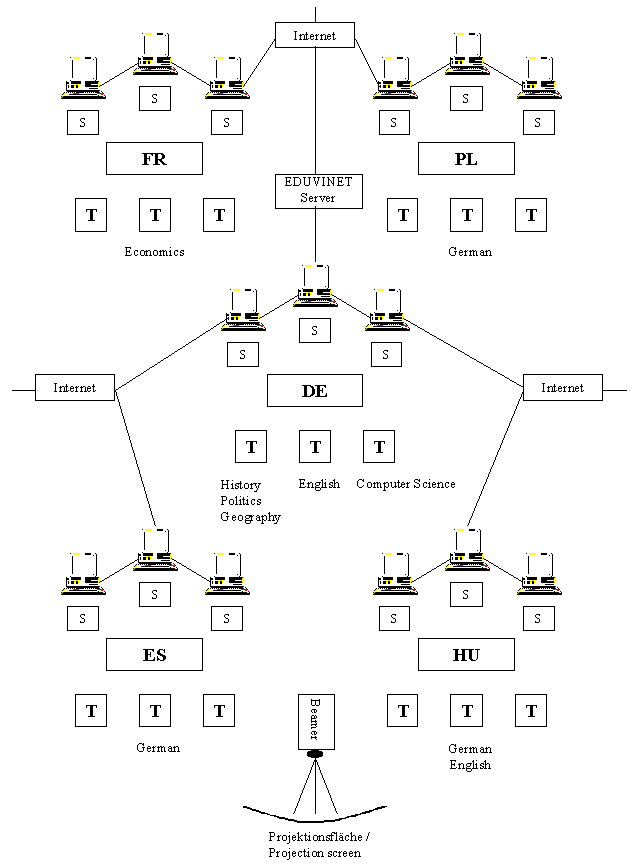
|
• • Copyright © IWB
e.V. 1996-2000 • Webmaster:
ohlendorf@eduvinet.de • •
• • 800 x 600 recommended • •